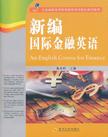新编国际金融英语
2011-1
苏州大学出版社
薛水明 编
199
这本《新编国际金融英语》是全国高职高专院校商务英语规划系列教材之一,由江苏南通紫琅职业技术学院薛水明教授主编。全书以语言、表格为载体,介绍国际金融领域最新知识,追踪国际金融领域最新趋势,关注新热点,阐述新现象,探讨新问题。内容涉及国际金融常识、国际结算操作、银行传统和新型业务知识以及保险业务介绍等。
Item OneA Brief Introduction to Banking
Industry
Task One: 常用金融专业术语解释
1. 金融的概念(Conceptof Finance)
2. 金融结构(Structure of Finance)
3. 金融体系(System of Finance)
4. 金融资产(Financial Assets)
5. 储蓄(Deposit)
6. 银行贷款的种类(Loan Types)
7. 存款准备金(Deposit Reserve)
8. 拨备率(Provision Rate)
Task Two: Reading Passages about Banking Industry
1. The History of the People's Bank of
China (PBC)
2. Bank of England
3. Bank of France
4. Money Doctor (1)
5. Money Doctor (2)
Item TwoPractical Knowledge about Foreign
Exchange
Task One: 外汇的概念及相关知识
1. 外汇的概念(Concept of Foreign Exchange)
2. 各国外汇的英文简称(English Abbreviations of the
Foreign Exchange in Different Countries)
3. 主要外汇(Chief Foreign Exchange)
4. 外汇市场的主要参与者(Chief Participants in Foreign
Exchange Market)
Task Two: Reading Passages about Foreign Exchange
1. Foreign Exchange
2. Foreign Exchange Market
3. Foreign Exchange Rate and Foreign
Exchange Market
4. International Trade
5. Visible Trade
6. Invisible Trade
Item ThreePromissory Note, Cheque and Bill of
Exchange
Task One: 本票、支票和汇票的区别
1. 本票(Promissory Note)
2. 支票(Cheque/Check)
3. 汇票(Bill of Exchange/Postal
Order/Draft)
4. 本票、支票和汇票的相同点与不同点(Similarities and
Differences among Promissory Note, Cheque and Bill)
Task Two: Reading Passages about Different Bills
1. English Expressions of Different
Cheques
2. A Promissory Note—a Legal
Agreement
3. Bills of Exchange
4. Sight and Term Bill of Exchange
5. Parties of a Bill
6. Uses of a Bill
Comprehensive Exercise
Item FourA Brief Introduction to Letter of Credit
Task One: 信用证业务
1. 信用证业务基本当事人(Parties Related to L/C
Business)
2. 假远期信用证(Usance L/C)
3. 保险单的种类(Kinds of Insurance
Policies)
4. 汇票(Bill of Exchange)
5. 出口商填制商业发票(Commercial Invoice Filled by
Exporter)
6. 提单的种类(Kinds of B/L)
Task Two: Reading Passages about L/C Business
1. Documentary Credit
2. Banks and Foreign Trade
3. The Main Documents Involved in the
Foreign Trade
4. Bills of Lading
5. Insurance Document
6. The Invoice and Other Documents
Item FiveCollection
Task One: 托收支付方式的业务程序
1. 托收方式的操作过程(Operation Process of
Collection Method)
2. 托收的种类(Kinds of Collection)
3. 出口商填制商业汇票(Commercial Bill Filled by
Exporter)
4. 托收业务中所需的其他票证样本(Other Samples)
Task Two: Reading Passages about Collection
1. The Clean Collection
2. Cheque and Bank Draft
3. Telegraphic Transfer
Item SixRemittance
Task One: 汇付的业务知识
1. 汇付的概念(Concept of Remittance)
2. 汇付的当事人(Parties of Remittance)
3. 汇付方式的种类及其业务程序(Types of Remittance and
the Business Procedure)
4. 汇付的应用(Application of Remittance)
5. 汇付的特点(Characteristics of
Remittance)
6. 相关票证样本(Samples of Relative
Documents)
Task Two: Reading Passages about Remittance
1. International Remittance
2. Remittance Route
3. A Method of Money Transfer
4. Information about Remittance
Comprehensive Exercise
Item SevenCredit Card
Task One: 信用卡业务知识
1. 信用卡的概念(Concept of Credit Card)
2. 信用卡的种类(Kinds of Credit Card)
3. 银行卡的申领(Application for Bank Card)
4. 银行卡的使用(Uses of Bank Card)
5. 银行卡的计息和收费(Interest Accrual and Charges
of Bank Card)
6. 银行卡的挂失(Loss Reporting of Bank
Card)
7. 银行卡联网通用(Networking Usage of Bank
Card)
Task Two: Reading Passages about Credit Card
1. Credit Card
2. History of Credit Card
3. Credit Card Economy
4. Uses of Credit Card
5. Advantages and Disadvantages of Credit
Card
Item EightGrowth of E-bank Services
Task One: 电子银行的发展
1. 电子银行的概念(Concept of E-bank)
2. 网络银行形式划分(Form Classification of Network
Bank)
3. 我国网络银行内部发展中的问题(Problems in the Internal
Development of Chinese Network Bank)
Task Two: Reading Passages about E-bank
1. E-bank Service
2. The Advantages of Internet Bank
3.Online Payment
4. A Service of Deutsche Telekom
Item Nine The Development of Insurance in China
Task One: 保险业务
1. 保险种类(Categories of Insurance)
2. 投保程序(Procedures of Buying
Insurance)
3. 保险人应承担的义务(Insurer's Obligation)
4. 中国十大保险公司排名及简要介绍(Ranking List and Brief
Introduction of Chinese Ten Chief Insurers)
Task Two: Reading Passages about Insurance
Business
1. The History of Insurance
2. Private Health Insurance
3. Interview: China's Insurance Market Has
Great Potential
4. Promoting Co-operation with Foreign
Insurance Firms
5. Guarding Against Financial
Uncertainty
6. Property Insurance
Comprehensive Exercise
附录《金融英语》课程标准
Cash withdrawal is very simple. When making withdrawals, you do not need to fill out the withdrawal slip. All you need to do is to present your bank book or bank card and tell the teller the amount you want to withdraw. If the amount you withdraw is not less than 50,000 yuan, you need to present your valid ID. When you make withdrawals with your password or seal, you need to enter your password on the password processor as required, or stamp the withdrawal slip with your seal. After finishing all the above procedures, you have to sign your name on the withdrawal slip. Within one minute, the bank will give you money and a bank receipt. Of course, there is something different between drawing cash from a savings deposit account and a time deposit account. You can withdraw cash at any time from a savings account. But if you withdraw cash from a time deposit account before the maturity date, the interest is computed at the interest rate for savings deposit instead of time deposit. By the way, using a bank card to withdraw cash is very convenient at an ATM machine.
To have solid foundation and basic skills of English language, including reading, listening, speaking, translating and writing To have some professional knowledge and skills in international trades, negotiating, international business laws. etc To possess some theories, involving finance, marketing, accounting, insurance logistics, etc To know about some of the foreign countries customs, social and cultural backgrounds
